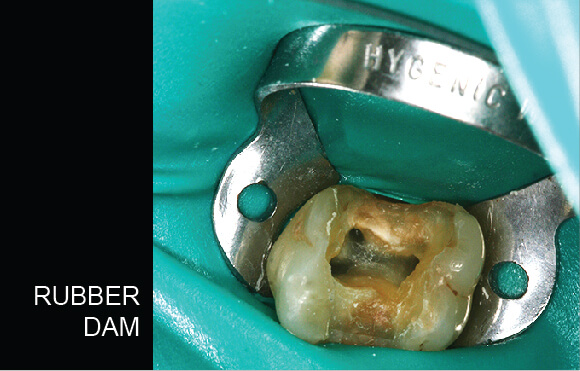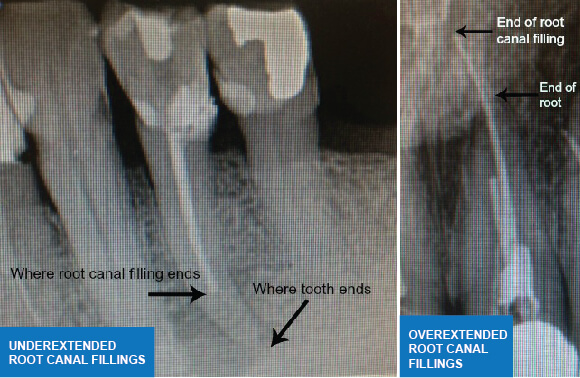Root Canal Treatment
Common Root Canal Treatment Failures and How to Prevent Them
Millions of people undergo root canal treatment each year to save their natural teeth. When performed correctly, root canals can last a lifetime. However, some procedures fail, leading to persistent pain, infection, or eventual tooth loss. The complexity of root canal systems, variations in treatment techniques, and post-procedure complications all contribute to these failures. Understanding these risks can help both patients and dentists take preventive measures and improve long-term success rates.
Top 10 Reasons For Why Root Canal Treatment Fail
Reason #10: Broken instruments in the Canal

Dentists use delicate tools to shape and clean root canals. Sometimes, a file or another instrument breaks inside the tooth, especially in narrow or curved canals. This problem occurs more often when using rotary instruments or older, weakened tools.
If the file breaks after the dentist has thoroughly cleaned the canal, they can still fill and seal the root. However, if breakage happens before cleaning, they must remove the fragment to prevent infection. Your teeth may require surgical root-end treatment if retrieval proves impossible.
To minimize the risk of instrument breakage, dentists should use high-quality nickel titanium files and replace worn instruments regularly. Proper technique, including reducing excessive pressure on tools, also helps prevent this issue.
Reason #9: Insufficient Disinfection of the Root Canal
Root canal treatment aims to remove dead or infected tissue and eliminate bacteria from the tooth’s internal structure. If a dentist fails to clean the canal thoroughly, bacteria may remain inside, leading to reinfection.
A rubber dam is essential during the procedure. This barrier isolates the tooth from saliva, which contains millions of bacteria that can contaminate the root canal. If a dentist performs a procedure without a dam, it increases the risk of failure.
Effective irrigation with disinfectants such as bleach and chelating agents ensures that bacteria and debris are completely removed. The cleaning process must reach the full length of the root canal, including accessory branches that may harbor bacteria.
Reason #8: Improper Filling Length
Accurate measurement of the canal length is critical for successful root canal treatment. If the dentist does not clean and fill the entire root canal system, infected tissue may remain inside. This can lead to abscess formation.
Conversely, overfilling can also cause problems. If the dentist extends the filling material beyond the root tip, the canal may lose its ability to seal properly. This overextension can also irritate surrounding tissues, causing persistent pain and inflammation.
Reason #7: Bacterial Leakage from the Restoration
After a root canal, the dentist must seal the treated tooth properly to prevent bacteria from re-entering. If the temporary or permanent restoration fails to create a strong seal, bacteria can penetrate the tooth and cause reinfection.
Placing a dental crown after treatment is crucial. A crown covers and protects the tooth while ensuring a tight seal. Timing also matters—delaying the final restoration increases the risk of contamination. If saliva touches the filling material (Gutta-Percha) for as few as three days, bacteria can infiltrate the root canal system. Should this happen, retreatment may be necessary.
Reason #6: Incomplete Canal Filling (known as obturation or canal filling)
After cleaning the canal, the dentist must fill and seal the space completely. The filling material should be tightly packed to prevent bacteria from re-entering the root system.
At Westcoast, advanced 3D filling techniques such as Thermafil, vertical warm condensation, and obtura backfilling ensure a dense, complete seal. These methods significantly reduce the risk of reinfection and increase long-term treatment success.
Reason #5: Missed or Hidden Root Canals
Some teeth have additional canals that are difficult to detect. For example, a lower incisor, which typically has one canal, may contain a second, hidden canal. If the dentist fails to locate and clean these extra canals, bacteria may remain inside, leading to infection.
Finding all canals is one of the most challenging aspects of root canal therapy. Dentists use advanced imaging techniques and specialized instruments to identify hidden canals. However, in rare cases, certain complex root structures may still go undetected.
Reason #4: Accidental Tooth Perforation
During root canal treatment, procedural errors sometimes occur. One common mistake is "stripping," where a file damages the side of a curved canal. Another serious issue is perforation. This happens when the dentist extends the drill beyond the root, or accidentally pushes a file through the tooth’s side.
These errors create openings that allow bacteria to enter, making it difficult to seal the canal properly. Dentists use special materials such as MTA (Mineral Trioxide Aggregate) to repair perforations. However, prevention remains the best approach, requiring careful technique and advanced training.
Reason #3: Canal Blockage
Some root canals are naturally calcified, making them difficult to clean. If the dentist cannot reach the end of the root, bacteria may remain inside, leading to reinfection.
Blockages may also result from procedural errors. If a file creates an unintended ledge or blockage, it can prevent proper cleaning and sealing. An artificial blockage caused by treatment errors increases the risk of failure.
Reason #2: Undetected Cracks in the Tooth
Dentists often find it difficult to diagnose cracked teeth. Some cracks become visible only after the dentist opens the tooth during the procedure. If a crack extends below the gum line, saving the tooth may not be possible.
In some cases, microscopic cracks remain hidden, making detection nearly impossible. Over time, bacteria can enter through these tiny fractures, leading to reinfection. Patients may undergo a root canal, receive a crown, and still experience persistent pain or infection. Routine X-rays and careful examination help detect cracks before treatment begins.
Reason #1: Complex Root Canal Anatomy
Every tooth has a unique internal structure. Some teeth contain extra canals, hidden branches, or curved roots that make treatment challenging, even with advanced instruments.
Back teeth, especially molars, have more roots and canals than front teeth, making them more complex to treat. In some cases, the root canal system may contain accessory canals that are impossible to access. This increases the risk of failure.
For the best root canal care, trust Westcoast. Our expert dentists use advanced technology to ensure precision, comfort, and long-lasting results. Don’t let dental pain linger—schedule your consultation today!















